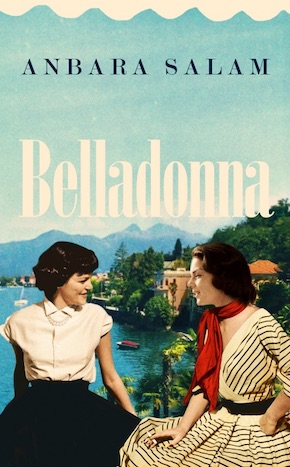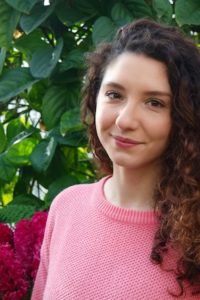Anbara Salam: Desire and betrayal
by Mark Reynolds
“Anbara Salam has a gimlet-eyed, ferocious talent for capturing the obsessive urgency and convolutions of power and desire.” Sharlene Teo
Anbara Salam’s second novel Belladonna is a mesmerising story of friendship, obsession, secrets and identity. In conservative Connecticut in the summer of 1956, 15-year-old Bridget Ryan delights in her friendship with cool, enigmatic, beautiful and brazen Isabella Crowley. The following summer, they both get the chance to spend a year in Italy studying at a lakeside academy where they live with other expat American girls among a convent of nuns who have taken a vow of silence. Isabella is again the centre of attention, and Bridget grows increasingly desperate to keep a place in her affections and establish her own popularity and acceptance – even if it means betraying her family and heritage.
MR: With its themes of adolescent love, infatuation, social transgression and coming of age, your new novel has been compared to The Talented Mr Ripley and The Virgin Suicides. There are also hints of Carol and Picnic at Hanging Rock. Were any of these books – or their film adaptations – a direct influence?
AS: I came to The Talented Mr Ripley quite late, and devoured all the ‘Ripliad’ books in a month. It was absolutely an influence on Belladonna, as I was thinking about how Ripley is such a terrible person, but as a reader you find yourself rooting for him. I loved the idea of creating a character who behaves more and more terribly but it happens so slowly that you almost don’t realise that you’re hoping their manipulations will be successful.
The book is set in the late 1950s, when teenagers generally were a lot less worldly than today; and your narrator Bridget Ryan is an embodiment of awkwardness, naïveté and contradictory impulses. What drove you to tell this story from her perspective rather than, say, the cool, alluring if carelessly cruel enigma that is Isabella Crowley?
The charismatic, cool Isabellas of the world are dramatic and dynamic – they make things happen, their lives are glamorous. But I’m so much more interested in ‘sidekicks’; the complex journey of someone who doesn’t see themselves as a protagonist, even in their own life story.
The perception of Italy in 1950s America had a specific allure that was important for facilitating a truly escapist move for the characters.”
What were the most fun and most frustrating things about writing from Bridget’s point of view?
I don’t often write in first-person and that had some great quirks and challenges. For example, how do you ‘show’ that someone is in denial if you’re in their head?
What lay behind your choice to uproot Bridget and Isabella from Connecticut to northern Italy rather than, say, Edinburgh to the south of France?
I initially wanted to write about the flooding in Connecticut in 1955, imagining what a defining moment that would be in a young person’s life. In the end, however, it didn’t quite fit the timeline so I had to cut that section. It was also important to maintain a level of glamour and ‘exoticising’ for the location of the Academy, and the perception of Italy in 1950s America had a specific allure that was important for facilitating a truly escapist move for the characters.
Are the Academy, lake and village based on a specific location? What lay behind the choice of Teresa as the local saint?
They are an amalgamation of a few real and make-believe places. The Academy, village, and lake are all inventions. However, I was thinking of a fantasy version of the Courtauld Institute of Art, in the location of somewhere like Lake Garda. ‘St Teresa of Pentila’ is absolutely based on St Teresa of Avila; the Spanish Carmelite nun and mystic writer.
A major part of Bridget’s insecurity lies in the fact she is mixed race. Since you are half-Scottish and half-Palestinian, raised in London and living in Oxford, you qualify as ‘minority ethnic’ (perhaps on two counts). Do you identify with the BAME label, and what do you consider to be its limitations?
There’s a lot of debate about how useful terms like BAME really are; on one hand, yes, in this country, I absolutely am from a ‘minority ethnic’ background, and it can be useful to have a way to structurally describe that experience. On the other hand, a term like BAME collapses the identities of so many people that it becomes almost meaningless. For example, it erodes the specific kinds of anti-Black systemic racism that can’t be extrapolated across different experiences.
How would you compare race relations today – in the UK, Italy and the US – with the time your parents and grandparents were coming of age?
The Loving v. Virginia case that resulted in ending miscegenation laws across the US took place in 1967. 1967! Mildred Loving died in 2008! It’s a testament to how much progress has been made that (white) people are often shocked to realise that Ruby Bridges, the first child to desegregate an elementary school in New Orleans (also famously depicted by Norman Rockwell) is only 65 today. Legally, there has been a great deal of progress to address racial equality since my parents/grandparents came of age; but the structural inequalities still persist, foundationally, and in more insidious ways.
I find the 1950s compelling from a narrative perspective, as it’s a cultural moment where pre-WWII values and ‘modernity’ as we might recognise it begin to clash.”
Do you consider that sexual equality and sexual freedom have fared better than racial equality over the past 50+ years?
That’s a hard question! I’m not sure that we can put the two in a competition because the civil rights movement and the struggle for LGBTQ+ rights have historically intertwined. Look at the role of Black trans women in Stonewall; and the high mortality rates for Black trans women even now, as a result of multi-layered discrimination. Conversations that pull apart different experiences of structural inequality often fracture the role of systemic oppression. Having said all that; I also think that there is a great deal more work to be done to specifically address anti-Black racism.
Things Bright and Beautiful was also set in the 1950s. What particularly draws you to that era? And what time period are you writing about next?
I find the 1950s compelling from a narrative perspective, as it’s a cultural moment where pre-WWII values and ‘modernity’ as we might recognise it begin to clash. At the moment, my work-in-progress is set in 1923, which is very different for me, and is bringing with it its own set of challenges – it’s taking me longer to write the manuscript as I keep having to stop and fact-check.
You have a PhD in Theology and wrote your doctorate on cults and contemporary apocalyptic belief. Is it fair to say that you’re against pious righteousness and extremism, whilst acknowledging the beneficial moral codes organised religions represent?
I’m not really ‘against’ any form of religious expression per se; what I find really interesting is how people can hold diverse and even contradictory truths at the same time. Someone could believe, for example, that Jesus is imminently about to return at any moment, and also be saving for their pension. The intersection between organised religion and personal decision-making fascinates me, both academically and in fiction.
Who would say are you literary heroes, and what have you been reading lately that you particularly recommend?
My author heroes include Toni Morrison, Angela Carter and Sarah Waters. In terms of recommendations, if you haven’t read The Confessions of Frannie Langton by Sara Collins, you must remedy that immediately!
How did you enjoy the Zoom launch of the US edition of Belladonna in June? And how has the novel been received in the States?
Lockdown has given me a chance to meet people I wouldn’t have done if I’d been in the US in person, so in many ways Zoom has been a fantastically accessible tool for talking about books. It’s hard for me to know how the novel has been received in the States! I don’t tend to read reviews as I totally respect individual interpretations and reactions, negative ones included. I feel that once a book is published, it’s for readers, and the reception doesn’t really ‘belong’ to me.
What are you most looking forward to doing once the coronavirus lockdown fully lifts?
Obviously seeing my family, but on a more shallow note, I keep picturing myself eating a prawn sandwich on a moving train. Where it’s going, I don’t even care, I would just like to be on a train, on my way somewhere, with a nice sandwich.
When and where are you happiest?
I hope my happiest is yet to come! But three years ago, while backpacking with my partner, we stopped to have lunch in a sunny square in Vienna. It was hot, the fish was fresh, I had a glass of rosé. I thought to myself – this is the happiest I have ever been. I think about that moment in technicolour, all the time, not because it was extraordinary, but because pure joy can visit us in the most mundane way. It reminds me it’s worth fighting for those moments.
 Anbara Salam is half-Palestinian and half-Scottish, and grew up in London. She has a PhD in Theology and lives and works in Oxford. She spent six months living on a small South Pacific island, and her experiences there served as the inspiration for her first novel, Things Bright and Beautiful. Belladonna is published in paperback, eBook and audio download by Fig Tree/Penguin.
Anbara Salam is half-Palestinian and half-Scottish, and grew up in London. She has a PhD in Theology and lives and works in Oxford. She spent six months living on a small South Pacific island, and her experiences there served as the inspiration for her first novel, Things Bright and Beautiful. Belladonna is published in paperback, eBook and audio download by Fig Tree/Penguin.
Read more
anbarasalam.com
@anbara_salam
Author portrait © Struan Murray
Mark Reynolds is a freelance editor and writer, and a founding editor of Bookanista.
@bookanista
wearebookanista


